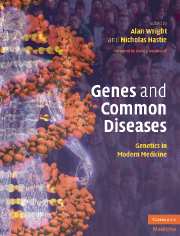Book contents
- Frontmatter
- Contents
- List of Contributors
- Foreword
- Section 1 Introductory Principles
- Section 2 Common Medical Disorders
- 13 Developmental disorders
- 14 Genes, environment and cancer
- 15 The polygenic basis of breast cancer
- 16 TP53: A master gene in normal and tumor suppression
- 17 Genetics of colorectal cancer
- 18 Genetics of autoimmune disease
- 19 Susceptibility to infectious diseases
- 20 Inflammatory bowel diseases
- 21 Genetic anemias
- 22 Genetics of chronic disease: obesity
- 23 Type 2 diabetes mellitus
- 24 Genetics of coronary heart disease
- 25 Genetics of hypertension
- 26 Obstructive pulmonary disease
- 27 Skeletal disorders
- 28 The genetics of common skin diseases
- 29 Molecular genetics of Alzheimer's disease and other adult-onset dementias
- 30 Major psychiatric disorders in adult life
- 31 Speech and language disorders
- 32 Common forms of visual handicap
- 33 Genetic and environmental influences on hearing impairment
- 34 Pharmacogenomics: clinical applications
- Index
- References
29 - Molecular genetics of Alzheimer's disease and other adult-onset dementias
Published online by Cambridge University Press: 17 August 2009
- Frontmatter
- Contents
- List of Contributors
- Foreword
- Section 1 Introductory Principles
- Section 2 Common Medical Disorders
- 13 Developmental disorders
- 14 Genes, environment and cancer
- 15 The polygenic basis of breast cancer
- 16 TP53: A master gene in normal and tumor suppression
- 17 Genetics of colorectal cancer
- 18 Genetics of autoimmune disease
- 19 Susceptibility to infectious diseases
- 20 Inflammatory bowel diseases
- 21 Genetic anemias
- 22 Genetics of chronic disease: obesity
- 23 Type 2 diabetes mellitus
- 24 Genetics of coronary heart disease
- 25 Genetics of hypertension
- 26 Obstructive pulmonary disease
- 27 Skeletal disorders
- 28 The genetics of common skin diseases
- 29 Molecular genetics of Alzheimer's disease and other adult-onset dementias
- 30 Major psychiatric disorders in adult life
- 31 Speech and language disorders
- 32 Common forms of visual handicap
- 33 Genetic and environmental influences on hearing impairment
- 34 Pharmacogenomics: clinical applications
- Index
- References
Summary
Alzheimer's disease (AD), Lewy body variant of Alzheimer disease (LBV), and the fronto-temporal dementias (FTD) are the three commonest causes of adult-onset dementia. These diseases present in mid to late adult life with progressive defects in memory and higher cognitive functions such as performing complex learned motor tasks (apraxias), reasoning etc. In the fronto-temporal dementias, the clinical syndrome can be overshadowed by behavioral disturbances (disinhibition, aggressivity etc.) and speech disturbances (aphasia), which arise from involvement of the frontal neocortex. The FTD symptom complex frequently also includes additional features such as muscle rigidity, tremor, bradykinesia (Parkinsonism), and motor neuron induced muscle weakness (amyotrophy). In contrast, the clinical features of AD and LBV (recent and immediate memory deficits, deficits in praxis, reasoning and judgement etc.) are those stemming from involvement of the temporal lobe, hippocampus, and the parietal association cortices, with lesser involvement of frontal lobes until late in the disease. LBV overlaps with AD, sharing most of the clinical and neuropathological features of AD, but being differentiated by the presence of prominent visual hallucinations, sensitivity to phenothiazine tranquilizers, and the presence of Lewy bodies (α-synuclein containing intraneuronal inclusions) in neocortical neurons. In all three diseases there is prominent loss of neurons in selected cerebral cortical regions (e.g. hippocampus and temporoparietal neocortices in AD and LBV; frontal neocortices in FTD). In AD and LBV, a second prominent neuropathological feature is the complex, extracellular, fibrillar deposits in the cortex termed senile or amyloid plaques.
- Type
- Chapter
- Information
- Genes and Common DiseasesGenetics in Modern Medicine, pp. 439 - 453Publisher: Cambridge University PressPrint publication year: 2007



